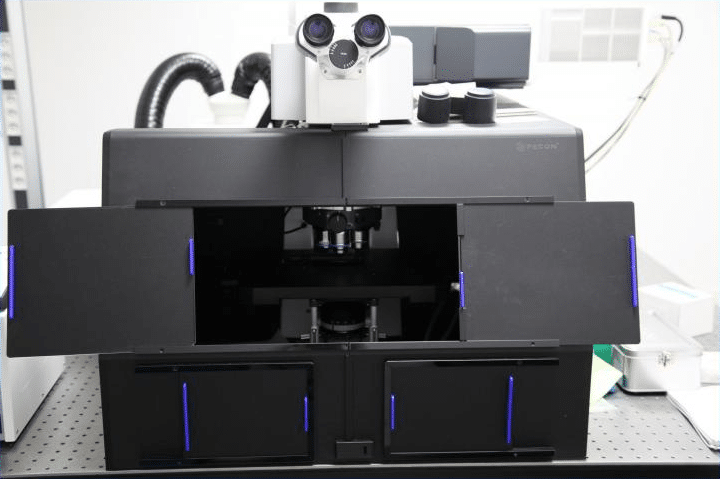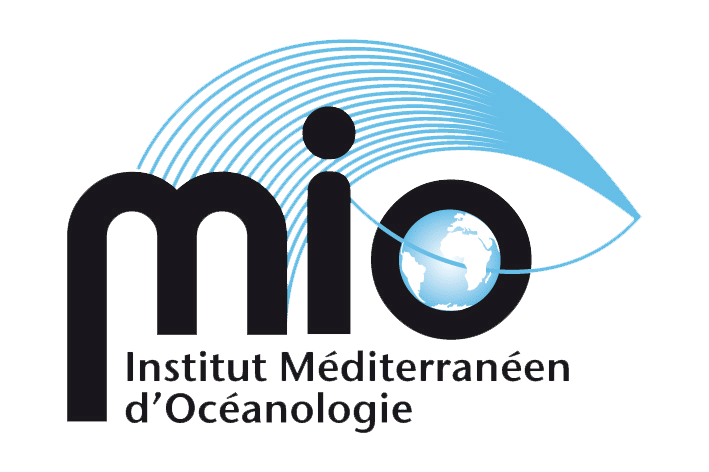SPECTROM
Le Spectroscopy, Optics and Imaging Division - Carbon, Nitrogen brings together the CEM team's expertise in fluorescence spectroscopy (continuous and time-resolved) and absorbance analysis, applied in particular to the characterisation of organic matter (OM) or the detection of fluorescent compounds, in the laboratory as well as on-site and in-situ.
In addition to this characterisation of OM, the centre also offers analyses of carbon and total nitrogen in the liquid and solid compartments.
The cluster recently acquired a laser scanning confocal/biphoton microscope, which can be used to obtain high-resolution images. Optical" sections with a thickness of around 0.4µm are obtained at different levels of the sample, enabling 3D reconstruction of the sample.
This microscope is also capable of providing fluorescence lifetime images (FLIM) from a few hundred picoseconds down to microseconds. A typical application of FLIM is FLIM - FRET (Förster Resonance Energy Transfer). FRET is a well-established technique for studying molecular interactions. The cluster will develop these F-techniques to study complexations between organic matter and emerging pollutants.
Complementary techniques are used to determine concentrations of dissolved organic and inorganic carbon (DOC and DIC) using a TOC-V analyser and total nitrogen (TN) using the appropriate module. A CHNS will provide an elemental analysis of the solid matrix (soil, sediment, etc.).

How it works
SPECTROM is located on the premises of the Institut Méditerranéen d'Océanologie (MIO), at the University of Toulon on 1er floor and 2th building R, Campus La Garde.
The referents are :
Christophe Le Poupon – Tel : 04 94 14 25 02 - mail : lepoupon@univ-tln.fr
Houssam Hajjoul – Tel : 04 94 14 27 94 - mail : hajjoul@univ-tln.fr
Access conditions
The Centre is accessible to all MIO and the scientific community: academics, industrialists and clinicians with study needs in UV-Visible spectroscopy (continuous and time-resolved fluorescence, fluorescence quenching, in-situ monitoring, etc.) and confocal microscopy (biphoton, 3D imaging, FLIM, FRET, FRAP, etc.).
To gain access to the self-service equipment, new users must undergo training on the equipment required, provided by the Hub's staff. Without this training, no novice user will be allowed to use the equipment. Access to the laser rooms is reserved for people with laser level I.
The Centre also offers simple services based on a research project or complete services from A to Z, including data analysis and results. In this case, the service is provided on the basis of a quotation after your request has been studied.
Users must provide all information relating to the possible risks for handlers. The cost of analysis is given in the summary table.
Use of equipment
Users authorised for free access undertake to systematically fill in the "user monitoring booklet" provided and to report any problems encountered during use on the booklet and on GRR. In the event of a malfunction, they must contact the equipment manager. All users are responsible for leaving the equipment clean and tidy at the end of the session.
Reservations
Reservations for equipment can only be made through the Intranet site or by PSOI-CN staff after validation of the analysis request. Users are notified by e-mail when a device is unavailable.
Services
For a service or collaboration, users (applicants) must request an appointment by e-mail or telephone with the Centre's managers in order to establish the costs and, if necessary, an estimate.
The Pôle can provide the following services:
- A consultancy business to study the fluorescence of organic matter
- Support during acquisitions on different instruments and during analysis on PARAFAC or deconvolution on MATLAB
- Theoretical and practical training :
- Fluorescence spectroscopy "source separation and time resolution - from photon to source" (40H)
- Laser risks and prevention "Laser risks and prevention awareness training for anyone working with laser sources" (4H).
Fluorescence spectroscopy analysis
- 2D Fluorescence Spectrum Measurement
- 3D Fluorescence Spectrum Measurement
- Fluorescence quenching
- Fluorescence Emission Excitation Matrix (FEEM)
- Time-to-live measurements (TRLF) on liquid and solid samples with lifetimes from nanoseconds to microseconds.
- PARAFAC breakdown of the ProgMEEF and ProgTIME programmes developed in the laboratory by Roland Redon
- Measurement of absorption in the 200-800 nm wavelength range using UV-Visible Spectroscopy.
Confocal UV, Visible and Biphotonic imaging analyses
- 3D imaging.
- Spectral imaging.
- Fluorescence redistribution after photobleaching (FRAP, FLIP)
- Fluorescence Lifetime (FLIM)
- Förster-type resonant energy transfer by FLIM
Equipment
- HITACHI F-7000
- HITACHI F-4500 with sample holder for automatic measurement of 16 samples
- SHIMADZU UV-1800
- Laser Spectra-Physics Quanta-Ray INDI Nd:YAG Wavelengths: 1064 nm, 532 nm, 355 nm and 266 nm -Pulse width: 3-5 ns - Frequency: 20 Hz
- EKSPLA picosecond Nd:YAG laser Wavelengths: 1064 nm, 532 nm, 355 nm and 266 nm - Pulse width: 20 ps - Frequency: 20 Hz
- Zeiss upright microscope LSM 880 Laser Visible 458, 488, 514, 561, 633 nm - LASER Ti:Sapphire Chameleon Ultra II from 680 to 1080 nm - HARMONIXX UV PULSED LINE 340 to 540 nm - FLIM-Becker system for lifetime measurement - Chamber with temperature regulation/gas injection
- TOC-V analyser - SHIMADZU
- Total nitrogen analyser, NT. TNM-1 module - SHIMADZU
- Elemental analyser CHNS, FLASH 2000 - ThermoScientific
Download the price list in pdf : ICI
Analysis request form : ICI




